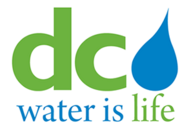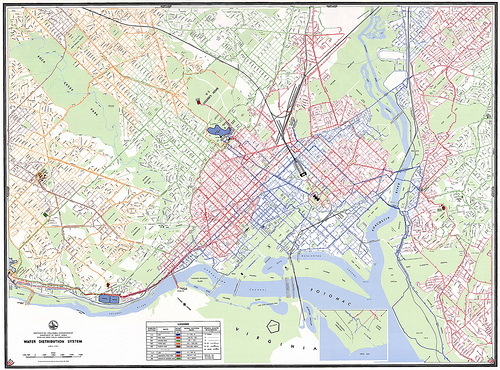Where does your DC Water come from?
Do you know where your water comes from? If you live in DC, it comes from one of several pumping stations, but the one that serves you might be all the way across town.
On Thursday, June 17th, I was invited (along with other local bloggers) to a roundtable with the General Manager of DC Water, George S. Hawkins.
Mr. Hawkins spoke about the culture of accountability he is nurturing at DC Water, formerly known as the DC Water and Sewer Authority or DC WASA.
He discussed the ongoing lead-in-the-water saga and spoke at length about his interest and excitement regarding all things environmental (he was formerly the head of the District Department of the Environment). Other bloggers have recently covered many of these points, and Greater Greater Washington will have other posts about this soon.
One of the most fascinating things we learned was the structure of DC’s water distribution. During our tour of the Bryant Street Pumping Station, we learned about the seven service areas that provide water to the residents and businesses of the city.
All the water DC uses comes from the Potomac River near Great Falls, is treated at the Dalecarlia Reservoir by the Washington Aqueduct (a division of the U.S. Army Corps of Engineers), and is then sold to DC Water. That water is then pumped to reservoirs all over the city. The reservoirs are located at different elevations, and they supply water to points below them. From those reservoirs, the water flows downhill (via gravity) to houses and businesses.
Here is their amazing map of the DC water system as of April 1985:
The color coding represents the approximate elevation of different parts of the city. Blue water mains run along roads at the lowest elevations (between zero and 70 feet above sea level). Red water mains are located at the second elevation range (between 70 and 140 feet), green at the third range, orange at the fourth, and brown at the highest elevations. The red and green areas east of the Anacostia River are separate zones than those west of the river, while the lowest zone (blue) spans both sides of the river.
This means that the reservoir that serves your house isn’t necessarily the one closest to your house, or even in your quadrant of the city! For example, our house is in Trinidad. While the closest reservoir is at Brentwood Parkway and New York Avenue (just north of Gallaudet University), we are served by reservoirs in Berkley and at the Armed Forces Retirement Home, both across town in the Northwest quadrant of the city.
Meanwhile, the reservoir nearest our house serves locations at the lowest elevations (below 70 feet), from lower Georgetown and Southwest in the west all the way to Rosedale and Deanwood in the east.
Some other examples of reservoirs and the neighborhods they serve:
- The reservoir at Van Ness and 44th NW serves neighborhoods at intermediate elevations across the city like Brookland, Woodridge, and Michigan Park in Northeast; Columbia Heights, Mt. Pleasant, Adams Morgan, and Kalorama in the center of the city; and Foxhall and the Palisades in Northwest.
- Two of the reservoirs at Fort Reno serve higher elevations like Glover Park, Cleveland Park, American University Park, and Forest Hills west of Rock Creek Park; and Petworth, North Portal Estates, Manor Park, and Takoma east of Rock Creek.
- The highest reservoir at Fort Reno serves the highest elevations in the city — neighborhoods like Tenleytown, Chevy Chase, and Shepherd Park.
Neighborhoods east of the Anacostia River have had a persistent problem with lower water pressure. DC Water is looking to rectify that with the construction of the new reservoir and pumping station in Ward 8. The construction of the new Department of Homeland Security headquarters on the campus of Saint Elizabeths will greatly increase demand for water in that part of town, and Mr. Hawkins said it would be a win-win for the neighborhood and DHS to get the new reservoir built as part of the new construction there.
Cross-posted at The District Curmudgeon.


